Beginners’ French: food and drink
Use 'Print preview' to check the number of pages and printer settings.
Print functionality varies between browsers.
Printable page generated Friday, 19 April 2024, 12:26 AM
Beginners’ French: food and drink
Introduction
In this free course, Beginners' French: food and drink, you will learn some basic vocabulary to talk about food and drink in French. You will learn how to express your likes and dislikes in relation to food, and you will learn how to order food and drinks in cafés or restaurants, and how to ask for your bill.
You will listen to French speakers in a variety of situations, and you will be provided with some skills for coping with reading texts. Cultural information throughout the course explains about customs surrounding meals and food habits in France.
This OpenLearn course is an adapted extract from the Open University course L192 Bon départ: beginners' French .
Learning outcomes
After studying this course, you should be able to:
express likes and dislikes in relation to food and drink
order food and drinks, and take part in simple exchanges
pay restaurant or café bills
demonstrate a better understanding of some food-related customs in France
know how to approach reading longer texts
1 Food in France
In this section you will learn how to talk about food in French. In particular, you will learn how to say what food you like and dislike using the verbs aimer (‘to like’), adorer (‘to love’), and préférer (‘to prefer’) and the negative structure ne … pas .
1.1 Talking about food in French
Many French people place a great deal of importance on food – as the British often resort to talking about the weather, French people will fill the conversation with what they had for dinner the night before or what they are thinking of cooking that evening. Despite the growth in supermarkets, most French people still buy their bread from a local baker, and often visit markets to stock up on fresh, locally produced fruit, vegetables and meat. And although the pace of modern life has certainly affected how people eat, preparing food and taking time to enjoy it remain important.
Most regions boast an impressive diversity of dishes. From bouillabaisse (a fish soup from Provence) to choucroute (a dish of sauerkraut, sausages and pork, popular in Alsace), there are dozens of dishes and drinks to try when visiting a new region. Some regional specialities, such as foie gras or champagne , have become internationally famous.
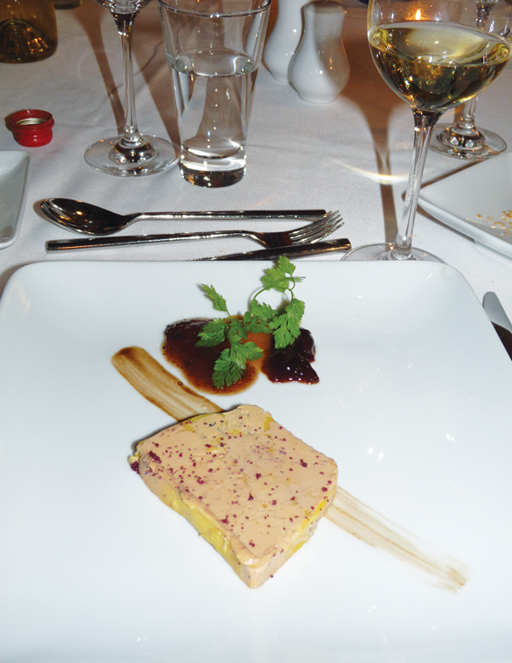
Activité 1
Task 1
Can you work out what the following French food items are? Drag the English words against the French terms they correspond to.
vegetables
les légumes
ice cream
la glace
cheese
le fromage
red meat
la viande rouge
pineapple
l’ananas
sea food
les fruits de mer
white wine
le vin blanc
fish
le poisson
raw vegetables
les crudités
Using the following two lists, match each numbered item with the correct letter.
vegetables
ice cream
cheese
red meat
pineapple
sea food
white wine
fish
raw vegetables
a.l’ananas
b.le fromage
c.les crudités
d.les légumes
e.le poisson
f.la viande rouge
g.la glace
h.le vin blanc
i.les fruits de mer
- 1 = d
- 2 = g
- 3 = b
- 4 = f
- 5 = a
- 6 = i
- 7 = h
- 8 = e
- 9 = c
Task 2
Claudette Dupont and her husband, Paul, have invited their friends the Lenoirs and the Khalifes for dinner on Saturday. Claudette has made a list of what her guests and her husband like to eat.
Read her notes and for each name, select the item(s) that person likes.
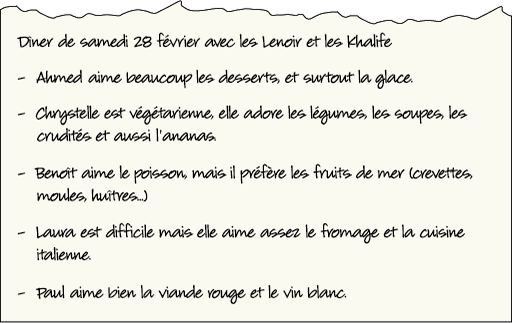
This is an image of some hand-written notes, in French, which read as follows:
Dîner de samedi 28 février avec les Lenoir et les Khalife
– Ahmed aime beaucoup les desserts, et surtout la glace.
– Chrystelle est végétarienne, elle adore les légumes, les soupes, les crudités et aussi l’ananas.
– Benoît aime les poisson, mais il préfère les fruits de mer (crevettes, moules, huîtres...)
– Laura est difficile mais elle aime assez le fromage et la cuisine italienne.
– Paul aime bien la viande rouge et le vin blanc.
a.
vegetables
b.
ice cream
c.
desserts
The correct answers are b and c.
a.
cheese
b.
vegetables
c.
soups
The correct answers are b and c.
a.
fish
b.
sea food
c.
white wine
The correct answers are a and b.
a.
cheese
b.
fruit
c.
Italian food
The correct answers are a and c.
a.
fish
b.
white wine
c.
red meat
The correct answers are b and c.
Activité 2
Task 1
We asked some French people what they like eating: Qu’est-ce que vous aimez manger ? Listen to the audio track, then select the correct answers below.
Transcript: Audio 1
Les Français à table
Colette
Maryse
Philippe
Lionel
a.
True.
b.
False.
The correct answer is a.
a.
True.
b.
False.
The correct answer is a.
a.
True.
b.
False.
The correct answer is b.
a.
True.
b.
False.
The correct answer is b.
a.
True.
b.
False.
The correct answer is a.
1.2 Talking about what food you like
Talking about what you like using aimer , adorer and préférer + le/la/les
To express your likes, you can use several verbs: aimer , adorer or préférer .
Benoît aime le poisson. Benoît likes fish.
Chrystelle adore les légumes. Chrystelle loves vegetables.
Il préfère les fruits de mer. He prefers sea food.
Note that you will need a definite article . le, la, l’ or les ) when using the verbs of liking with a noun:
Il aime le poisson. He likes fish.
Il aime la viande. He likes meat.
Elle adore l ’ananas. She loves pineapple.
J’aime les desserts. I love dessert.
Beaucoup (‘a lot’), bien (‘rather a lot’) and assez (‘quite’), placed after the verb aimer , are used to say how much you like things. Surtout means ‘above all’.
Activité 3
a.
les courgettes
b.
les carottes
c.
les haricots verts
d.
les frites
e.
les pâtes
f.
le poulet
g.
la viande
h.
la sauce tomate
i.
la confiture
j.
le gruyère
k.
le poisson
l.
l’avocat
m.
les betteraves
The correct answers are c, e, g, h, j, k and m.
Comment
Here are the translations of these words: les carottes (carrots); les haricots verts (green beans); les frites (chips); les pâtes (pasta); le poulet (chicken); la viande (meat); la sauce tomate (tomato sauce); la confiture (jam); le gruyère (Gruyère/hard cheese); le poisson (fish); l’avocat (avocado); les betteraves (beetroot).
Activité 4
Now you are going to practise saying what you like and how much you like it. Listen to the questions and the prompts. Speak in the gaps to give your answers.
Exemple
(You hear) Vous aimez la cuisine italienne ?
(You hear) (Beaucoup)
(You say) Oui, j’aime beaucoup la cuisine italienne.
Transcript: Audio 2
Vous aimez la cuisine italienne ?
(Beaucoup)
Oui, j’aime beaucoup la cuisine italienne.
Vous aimez les fruits de mer ?
(Assez)
Oui, j’aime assez les fruits de mer.
Vous aimez la viande ?
(Bien)
Oui, j’aime bien la viande.
1.3 Talking about what you dislike
To talk about what you dislike, you can use the negative form of the verbs used to express what you like. To form the negative in French, use ne before the verb and pas after the verb .ne becomes n’ in front of a verb starting with a vowel sound or an ‘h’):
Elle n’ aime pas les oignons. She doesn’t like onions.
Il n’ est pas français. He is not French.
You can use beaucoup and du tout with je n’aime pas to say how much you dislike something. If you use these words, they go after ne ... pas in the sentence:
Je n’ aime pas du tout la viande. I don’t like meat at all.
Il n’ aime pas beaucoup la cuisine nord-africaine. He doesn’t like North African food very much.
Note that in informal spoken French, people often omit the ne,
Je n’habite pas en France.→ J’habite pas en France. (I don’t live in France.)
Elle n’aime pas les sardines. → Elle aime pas les sardines. (She doesn’t like sardines.)
Activité 5
Claudette has just found out what her guests do not like to eat. Read her notes and identify all the words and phrases which express dislike.
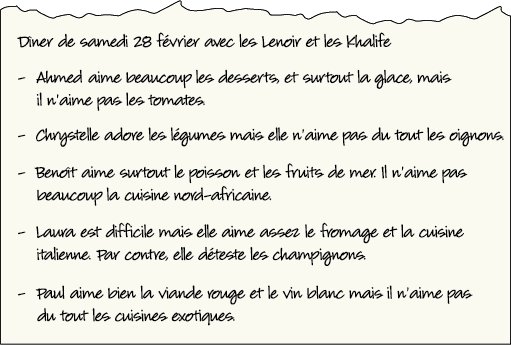
This is an image of some hand-written notes, in French, which read as follows:
Dîner de samedi 28 février avec les Lenoir et les Khalife
– Ahmed aime beaucoup les desserts, et surtout la glace, mais il n’aime pas les tomates.
– Chrystelle adore les légumes mais elle n’aime pas du tout les oignons.
– Benoît aime surtout les poisson et les fruits de mer. Il n’aime pas beaucoup la cuisine nord-africaine.
– Laura est difficile mais elle aime assez le fromage et la cuisine italienne. Par contre, elle déteste les champignons.
– Paul aime bien la viande rouge et le vin blanc mais il n’aime pas du tout les cuisines exotiques.
Answer
You should have identified:
n’aime pas , for Ahmed
n’aime pas du tout , for Chrystelle
n’aime pas beaucoup , for Benoît
déteste , for Laura
n’aime pas du tout , for Paul.
Activité 6
Answer the following questions in the negative, using whole sentences and ne/n’ … pas, as shown in the example. Remember to put the negative elements in the correct place in your sentences.
Exemple
Il aime le poulet ? Non, il n’ aime pas le poulet.
Vous êtes docteur ? Non, je ne suis pas docteur.
- Vous êtes professeur ?
- Ils viennent de Montréal ?
- Vous aimez les huîtres ?
- Il parle portugais ?
- Vous avez 35 ans ?
- Elle habite en Angleterre ?
- Il est végétarien ?
- Elles sont étudiantes ?
Answer
You should have answered as follows.
- Non, je ne suis pas professeur.
- Non, ils ne viennent pas de Montréal.
- Non, je n’aime pas les huîtres.
- Non, il ne parle pas portugais.
- Non, je n’ai pas 35 ans.
- Non, elle n’habite pas en Angleterre.
- Non, il n’est pas végétarien.
- Non, elles ne sont pas étudiantes.
Note that n’ is used instead of ‘ne’ in sentences 3, 5, 6 and 7 because the verbs in question begin with a vowel or an ‘h’.
Activité 7
Claudette’s son, Frédéric, is a very fussy eater. There are many things he won’t eat or drink. Listen to the audio track and, putting yourself in Frédéric ’s shoes, answer all the questions in the negative following the prompts you hear.
Exemple
(You hear) Tu aimes le café, Fred ?
(You hear) (Say no, you do not like coffee.)
(You say) Non, je n’aime pas le café.
Transcript: Audio 6
(Say, no, you do not like coffee.)
(Say, no you hate fish.)
(Say, no, you don’t like meat at all.)
(Say, no, you can’t stand vegetables.)
(Say, no, you don’t like ice cream very much.)
(Say, no, you hate seafood.)
Activité 8
Claudette would like to invite you to her dinner party. Write a short message in French to tell her what kind of food you like and dislike.
Answer
Here is one possible answer.
J’aime beaucoup les fruits de mer. J’aime aussi le poisson. J’adore la glace. Je n’aime pas du tout la viande rouge et je déteste les oignons. J’ai horreur des fast-foods !
Did you use a range of expressions from this section to express likes and dislikes?
2 Eating out in France
In this section you will learn how to order food using je voudrais, and you will learn vocabulary that is useful when you eat at a restaurant in France. You will read about eating out in France.
2.1 Types of restaurants and menus
You can find all sorts of different restaurants in France. There are Italian restaurants and pizzerias in practically every town; Vietnamese restaurants are also common. North African immigrants (from Algeria, Tunisia and Morocco) brought couscous (a grain related to semolina cooked with mutton, vegetables and spices), merguez (a spicy lamb sausage) and taboulé (a cold salad made with bulgur wheat and flavoured with mint and lemon).
‘Fusion’ cuisine, which makes use of a combination of international cooking styles, is on offer in a small but growing number of restaurants in France. However, it’s not easy to find vegetarian restaurants.
Le menu or la carte ?
Both le menu and la carte can be translated as ‘menu’ in English. French people will use either to request the menu in a restaurant. However, le menu is always used to refer to set menus. These are normally printed on a separate page in the menu . la carte ) or advertised at the entrance of the restaurant. Set menus can be advertised as, for example, menu à 21 €, menu gastronomique, menu touristique . The expression à la carte is used when you order your dishes from the full range of what is on offer. In brasseries and sandwicheries you may see the word formule instead of menu .
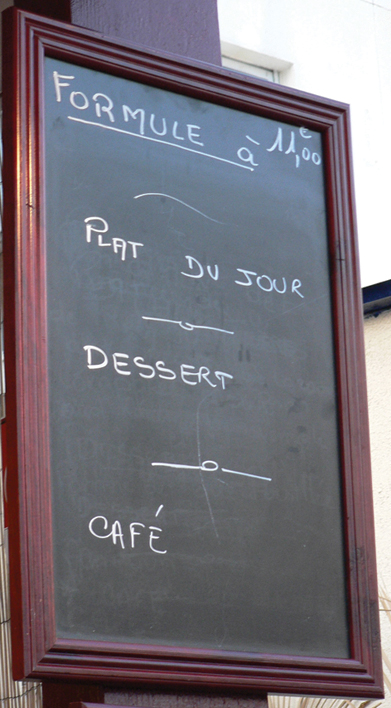
Activité 9
Look at the following pictures of restaurants and match them to the descriptions below, according to the type of cuisine they offer.
(Click on the photos or the words ‘View larger image’ to display a larger version of the photos.)
- a.un restaurant grec
- b.une couscousserie
- c.un restaurant kebab turc
- d.une pizzeria
- e.un restaurant de cuisine française
Answer
The correct answers are:
1 b 2 e 3 a 4 d 5 c
Activité 10
You are in a café-brasserie Le Bistro du Musée, deciding what to order. Look at the food items below and match the English dishes with their French equivalent.
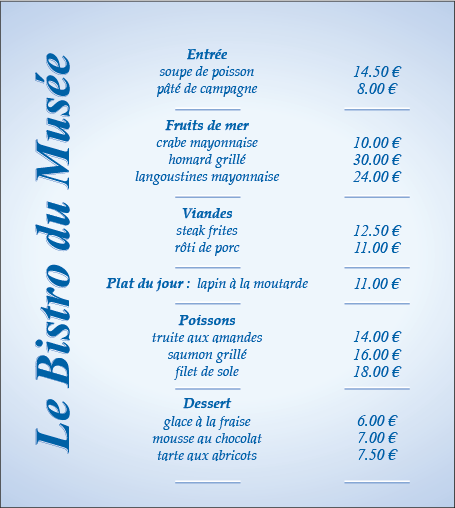
This is an image of a menu, which reads as follows:
Le Bistro du Musée
Entrée, soupe de poisson 14.50 €; pâté de compagne 8.00 €
Fruits de mer, crabe mayonnaise 10.00 €; homard grillé 30.00 €; langoustines mayonnaise 24.00 €
Viandes, steak frites 12.50 €; rôti de porc 11.00 €
Plat du jour, lapin à la moutarde 11.00 €
Poissons, truites aux amandes 14.00 €; saumon grillé 16.00 €; filet de sole 18.00 €
Dessert, glace à la fraise 6.00 €; mousse au chocolat 7.00 €; tarte aux abricots 7.50 €
a starter
une entrée
rabbit in mustard sauce
lapin à la moutarde
apricot tart
tarte aux abricots
today’s special
plat du jour
Using the following two lists, match each numbered item with the correct letter.
a starter
rabbit in mustard sauce
apricot tart
today’s special
a.plat du jour
b.une entrée
c.tarte aux abricots
d.lapin à la moutarde
- 1 = b
- 2 = d
- 3 = c
- 4 = a
2.2 Ordering food at a restaurant
Using je voudrais + un/une + noun to order food
To order food, you can simply use the indefinite article un (masculine) or une (feminine) + the item. You would normally add s’il vous plaît (‘please’), at the end of the sentence:
Une soupe de poisson, s’il vous plaît. One fish soup, please.
If you want to order a specific quantity of items, you use the relevant number:
Trois croissants. Three croissants.
Deux pains au chocolat. Two pains au chocolat.
Un rôti de porc. One (plate of) roast pork.
You can also use the polite form (‘would like’) of the verb vouloir (‘want’): Je voudrais (‘I would like’) + article + item:
Je voudrais un rôti de porc. I’d like the roast pork.
Je voudrais une mousse au chocolat. I’d like the chocolate mousse.
Activité 11
You are about to have your lunch at the café-brasserie Le Bistro du Musée. You are going to place your order. Listen to the waitress and the prompts, and answer in the gaps in the audio track. To check your answers, look at the transcript.
Transcript: Audio 8
(Crabe mayonnaise)
(Lapin à la moutarde)
(Tarte aux abricots)
Café culture
If you order un café in France you will get un express (a strong black coffee). Make sure you say un grand café or un café allongé if you want a large black coffee, un café crème or just un crème if you want white coffee, and un grand crème if you want it large.
Traditional cafés in France are places where people go at any time of day and consume different drinks depending on the time of day. The food served in cafés is limited to light snacks, such as sandwiches or croque-monsieur . American-style coffee shops can now be found in larger French towns and cities, but are not as popular as traditional cafés.
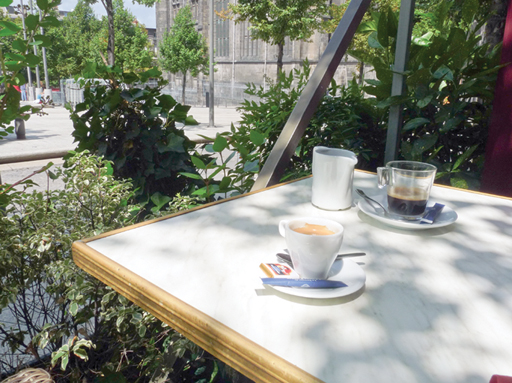
2.3 Paying your bill at a restaurant
This section teaches you how to pay your bill after a meal at a restaurant. You will also find out about the café culture in France.
Paying your bill: using ça fait / c’est combien ?
To ask for the price of an item or a meal, you can use:
C’est combien ?
Ça fait combien ?
Ça coûte combien ?
All mean ‘How much does it cost?’. Note that Ça coûte combien ? or Il/elle coûte combien ? tend to be used for items in shops.
Il coûte combien, ce T-shirt ? How much does this T-shirt cost?
To signal that you want to pay in a café or restaurant, you can use:
L’addition, s’il vous plaît. The bill, please.
The answer will be expressed in one of the following ways:
Vingt euros cinquante.
C’est vingt euros cinquante.
Ça coûte vingt euros cinquante.
Ça fait vingt euros cinquante.
All of which mean ‘That’ll be/That’s twenty euros fifty, please’.
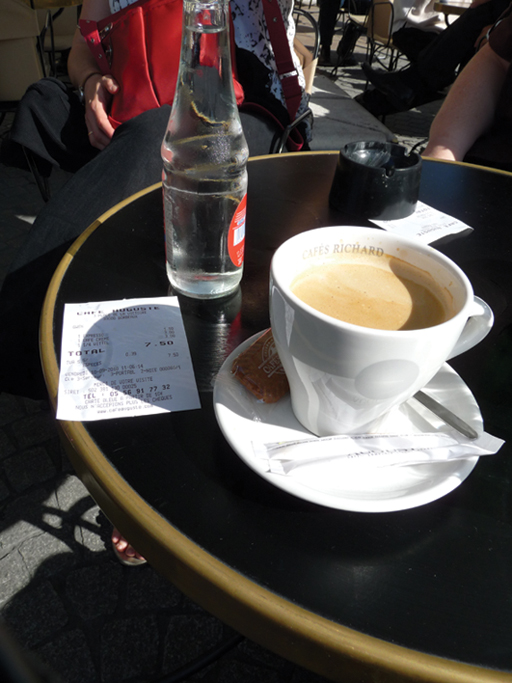
Activité 12
Now listen to the audio track below, paying attention to the questions and the prompts in the three dialogues. Play the role of the customer. Speak in the pauses following the prompts. To check your answers, look at the transcript.
Transcript: Audio 23
Dialogue 1
À la Brioche Dorée
(Ask how much it is, please.)
(Repeat ‘four euros fifty!’ and ask how much does one pain au chocolat cost.)
(Say, okay. Here you are then.)
(Say, thank you, you too.)
Dialogue 2
Au café
(Call the waiter, and ask for the bill.)
Dialogue 3
Dans un magasin
(Ask how much the truffle paté costs. 20 euros? Are you sure?)
(Say, good, that’s more like it.)
3 Talking about eating habits
In this section you will practise talking about what you eat, talking about different meals and eating habits.
Activité 13
Task 1
Match the French phrases below with their English translations.
You are thirsty.
Vous avez soif.
You are hungry.
Vous avez faim.
You are on a diet.
Vous faites un régime.
Have a large meal.
Faire un gros repas.
You don’t drink anything.
Vous ne buvez rien.
You eat nothing.
Vous ne prenez rien / vous ne mangez pas.
A fizzy drink.
Une boisson gazeuse.
It’s Christmas.
C’est Noël.
Using the following two lists, match each numbered item with the correct letter.
You are thirsty.
You are hungry.
You are on a diet.
Have a large meal.
You don’t drink anything.
You eat nothing.
A fizzy drink.
It’s Christmas.
a.Faire un gros repas.
b.Vous ne buvez rien.
c.Vous ne prenez rien / vous ne mangez pas.
d.Vous avez soif.
e.Vous faites un régime.
f.Vous avez faim.
g.C’est Noël.
h.Une boisson gazeuse.
- 1 = d
- 2 = f
- 3 = e
- 4 = a
- 5 = b
- 6 = c
- 7 = h
- 8 = g
Task 2
You want to eat healthily. Select the right answers in the quiz.
a.
Vous aimez manger une barre de chocolat.
b.
Vous mangez un ou deux fruits.
c.
Vous ne mangez pas.
The correct answer is b.
a.
Vous préférez une boisson gazeuse.
b.
Vous ne buvez rien.
c.
Vous prenez de l’eau minérale.
The correct answer is c.
a.
Vous ne mangez pas.
b.
Vous buvez du café.
c.
Vous prenez des céréales, un thé et un fruit.
The correct answer is c.
a.
En général vous aimez faire un gros repas, de la viande, des frites et un dessert au chocolat.
b.
Vous préférez travailler et vous ne prenez rien.
c.
Vous mangez un sandwich, un fruit et un yaourt.
The correct answer is c.
a.
Vous mangez et buvez beaucoup.
b.
Vous prenez de tout en petite quantité.
c.
Vous faites un régime et choisissez de ne rien manger.
The correct answer is b.
3.1 Reading longer texts
In this section you will learn some tips to help you read longer texts in French. When you read longer texts, first look at the title, which will help you identify the topic and give you an idea of the content.
Illustrations (if there are any) may also help you to understand what a text is about.
Remember that there are usually a number of words in any text that are similar to those used in English. Using them as clues, you can often understand quite a lot of a text without resorting to your dictionary.
Aim to get the gist without attempting to understand every word. Use your dictionary if you need a more detailed comprehension.
Activité 14
Task 1
Read the text Les Français et les repas .
Les Français et les repas
Qu’est-ce qu’on mange en France ?
Le petit déjeuner
- 2% des Français ne prennent pas de petit déjeuner.
- La plupart des Français boivent plutôt du café (59%).
- 11% boivent un jus de fruits et 5% mangent un fruit le matin.
- Seulement 7% mangent des céréales.
- 59% mangent des tartines avec du beurre et/ou de la confiture.
- Le week-end, 17% des Français mangent des croissants, des pains au chocolat ou des pains aux raisins.
Le déjeuner
- 68% des Français déjeunent généralement chez eux en semaine.
- La plupart des Français (66%) mangent de la viande (bœuf, porc, poulet…)
- 38% mangent des légumes.
- Seulement 3% mangent un sandwich.
- 4% prennent un plateau-repas dans leur canapé.
- 17% (surtout les hommes et les personnes de plus de 55 ans) prennent une entrée, un plat et un dessert.
- De plus en plus, on prend un plat unique à midi.
Le dîner
- Le soir, les Français mangent en famille.
- Ils mangent souvent un repas complet (entrée, plat, et dessert).
- Les personnes de plus de 50 ans mangent souvent de la soupe et du fromage.
- Un Français sur dix mange des œufs le soir.
- Normalement on mange du fromage et un dessert.
- On boit de l’eau ou du vin.
- Le repas préféré des jeunes, c’est le steak-frites.
Find the French for:
- breakfast, lunch and dinner
- at home
- one-course meal
- TV dinner
- at lunchtime
- three-course meal
Answer
The correct answers are:
- breakfast, lunch and dinner: le petit déjeuner (breakfast); le déjeuner (lunch); le dîner (dinner).
- at home: chez eux
- one-course meal: plat unique
- TV dinner: un plateau-repas
- at lunchtime: à midi
- three-course meal: repas complet
Task 2
Read the text Les Français et les repas again and decide if the following statements are true or false.
a.
True.
b.
False.
The correct answer is b.
a.
True.
b.
False.
The correct answer is a.
a.
True.
b.
False.
The correct answer is a.
a.
True.
b.
False.
The correct answer is b.
a.
True.
b.
False.
The correct answer is a.
a.
True.
b.
False.
The correct answer is a.
a.
True.
b.
False.
The correct answer is b.
4 Pronouncing the sounds [ s ] and [ z ]
In this section you will practise pronouncing the sounds [ s ] and [ z ].
Where there is a single ‘s’ between two vowels in a word, it is pronounced [ z ] as in ‘zero’, for example in the word poison. Where there is a double ‘s’ between two vowels this is pronounced [ s ] as in ‘mass’, for example in the word poisson. It is very important to distinguish between these sounds, as some words with quite similar spellings but very different meanings could otherwise be confused, e.g. dessert (‘dessert’) and désert (‘desert’)!
Activité 15
Task 1
Listen to the audio track and select whether you hear an ‘s’ sound (as in poisson) or a ‘z’ sound (as in raisin).
Transcript: Audio 17
assiette, raisin, parmesan, soupe, croissant, pissaladière, boisson, cuisine, spécialités, soufflé, poisson, poison, désert, dessert
a.
[s]
b.
[z]
The correct answer is a.
a.
[s]
b.
[z]
The correct answer is b.
a.
[s]
b.
[z]
The correct answer is b.
a.
[s]
b.
[z]
The correct answer is a.
a.
[s]
b.
[z]
The correct answer is a.
a.
[s]
b.
[z]
The correct answer is a.
a.
[s]
b.
[z]
The correct answer is a.
a.
[s]
b.
[z]
The correct answer is b.
a.
[s]
b.
[z]
The correct answer is a.
a.
[s]
b.
[z]
The correct answer is a.
a.
[s]
b.
[z]
The correct answer is a.
a.
[s]
b.
[z]
The correct answer is b.
a.
[s]
b.
[z]
The correct answer is b.
a.
[s]
b.
[z]
The correct answer is a.
Activité 16
Task 1
In this activity you will practise the pronunciation of the sounds [ s ] and [ z ].
Listen to each of the recordings below, then practise repeating the words with the appropriate pronunciation.
1.
2.
3.
4.
5.
6.
Conclusion
We hope you have enjoyed this course. Now that you know how to talk about what food you like and dislike, and that you have learned how to order food in a restaurant and what to say when you pay for it, you may wish to try this language out on your next visit to France or to another French-speaking country!
If you enjoyed this course, you might be interested in studying the Open University module L192 Bon départ: beginners' French. Or, if you are interested in other language short courses, rather than studying languages for a degree, you may want to have a look at what else is on offer here.
Take the next step

If you enjoyed this course, why not explore the subject further with our paid-for short course, Beginners French 1: eh oui!?
Acknowledgements
Except for third party materials and otherwise stated (see terms and conditions), this content is made available under a Creative Commons Attribution-NonCommercial-ShareAlike 4.0 Licence .
Course image: Alex Brown in Flickr made available under Creative Commons Attribution-NonCommercial-ShareAlike 2.0 Licence .
The material acknowledged below is Proprietary and used under licence (not subject to Creative Commons Licence). Grateful acknowledgement is made to the following sources for permission to reproduce material in this free course:
Every effort has been made to contact copyright owners. If any have been inadvertently overlooked, the publishers will be pleased to make the necessary arrangements at the first opportunity.
Don't miss out
If reading this text has inspired you to learn more, you may be interested in joining the millions of people who discover our free learning resources and qualifications by visiting The Open University – www.open.edu/ openlearn/ free-courses.
Copyright © 2016 The Open University
